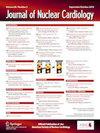Diagnostic performance of 18F-flurpiridaz PET myocardial perfusion imaging with total perfusion deficit quantification
IF 2.7
4区 医学
Q2 CARDIAC & CARDIOVASCULAR SYSTEMS
引用次数: 0
Abstract
Purpose
To assess the diagnostic performance of 18F-flupiridaz positron emission tomography (PET) myocardial perfusion imaging (MPI) for coronary artery disease detection using total perfusion deficit (TPD), an automated metric of combined disease extent and severity.
Methods
Flurpiridaz relative perfusion images and quantitative coronary angiography data from the initial phase III trial were evaluated using receiver operating characteristic analysis at separate endpoints of ≥70% stenosis and ≥50% stenosis, to determine the diagnostic performance of TPD at per-patient (global LV) and per-vessel levels. TPD results at both endpoints were compared with the performance of visual scores and defect extent values available from two previous publications.
Results
Using a normal perfusion database that was created with the data of 25 patients from the flurpiridaz trial population, TPD was calculated in the remaining 729 trial patients. At the threshold of ≥70% stenosis, TPD was observed to have similar (P ≥ .05) per-patient diagnostic performance (74% accuracy) to visual scoring from previous publications (75%, 71%), as well as defect extent (72%). At the per-vessel level, the TPD achieved similar performance to defect extent in the left anterior descending artery (LAD) and left circumflex artery (LCx) (79%, 74% vs 80%, 72% accuracy) with slightly higher accuracy in the right coronary artery (RCA) (77% vs 72%, P = .03), and similar performance to visual scoring in the LAD and RCA (77, 79% vs 76%, 76% accuracy) with marginally lower performance in the LCx (74% vs 79%, P = .03). Similar results were observed at the ≥50% obstructive disease endpoint.
Conclusions
Automated TPD demonstrated similar diagnostic performance for global and regional flurpiridaz PET MPI, respectively, to visual scoring and defect extent quantification.
18f -氟吡唑PET心肌灌注显像总灌注缺陷定量诊断价值
目的:评估18f -氟吡唑PET心肌灌注显像(MPI)在冠状动脉疾病检测中的诊断性能,总灌注缺陷(TPD)是一种综合疾病程度和严重程度的自动指标。方法:对初始III期试验的氟吡达相对灌注图像和定量冠状动脉造影数据进行评估,使用狭窄≥70%和≥50%的单独终点的受试者工作特征分析,以确定TPD在每个患者(全局LV)和每个血管水平上的诊断性能。两个终点的TPD结果与先前两篇出版物中提供的视觉评分和缺陷程度值的表现进行比较。结果:使用氟吡达试验人群中25例患者的数据创建的正常灌注数据库,计算其余729例受试者的TPD。在狭窄≥70%的阈值下,观察到TPD的每例诊断性能(74%准确率)与先前出版物的视觉评分(75%,71%)以及缺陷程度(72%)相似(p≥0.05)。在每个血管水平上,TPD在LAD和LCx的缺陷程度上取得了相似的表现(79%,74%对80%,72%准确率),在RCA的准确度略高(77%对72%,p = 0.03),在LAD和RCA的视觉评分方面取得了相似的表现(77,79%对76%,76%准确率),在LCx的表现略低(74%对79%,p = 0.03)。在≥50%的阻塞性疾病终点观察到类似的结果。结论:在视觉评分和缺陷程度量化方面,自动TPD分别对氟吡唑PET MPI具有相似的诊断效果。
本文章由计算机程序翻译,如有差异,请以英文原文为准。
求助全文
约1分钟内获得全文
求助全文
来源期刊
CiteScore
5.30
自引率
20.80%
发文量
249
审稿时长
4-8 weeks
期刊介绍:
Journal of Nuclear Cardiology is the only journal in the world devoted to this dynamic and growing subspecialty. Physicians and technologists value the Journal not only for its peer-reviewed articles, but also for its timely discussions about the current and future role of nuclear cardiology. Original articles address all aspects of nuclear cardiology, including interpretation, diagnosis, imaging equipment, and use of radiopharmaceuticals. As the official publication of the American Society of Nuclear Cardiology, the Journal also brings readers the latest information emerging from the Society''s task forces and publishes guidelines and position papers as they are adopted.

 求助内容:
求助内容: 应助结果提醒方式:
应助结果提醒方式:


